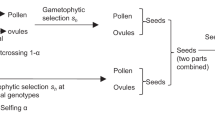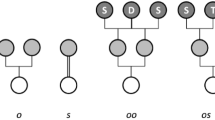Summary
Rates and patterns of male gamete incorporation for a polycross mating design were studied for two independent years of pollination in Norway spruce, Picea abies (L) Karst. Segregation distortion in a subset of maternal clones was documented for one locus. We have proposed a model, involving the existence of a linked lethal allele, which accounts for these observations. Significant temporal and maternal clonal differences were observed in the rates at which single locus and multilocus gametes were incorporated. Striking differences in apparent fertility existed among four clones which produced unique multilocus gametes. One clone, in particular, was shown to be contributing three times as many gametes to the next generation as predicted by the hypothesis of equal clonal male contribution. These deviations from expectation were also detected in the genotypic distributions of the resultant filial generation. Ramifications of these results on family structures in the filial generation, effective size of the male population, and possible bias in inferences of genetic differences and parameter estimation are discussed.
Similar content being viewed by others
References
Burdon RD, Shelbourne CAJ (1971) Breeding populations for recurrent selection: Conflicts and possible solutions. NZ J Forest Sci 1:174–193
Cheliak WM, Pitel JA, Murray G (1985) Population structure and the mating system of white spruce. Can J Forest Res 15:301–308
Franklin EC (1971) Pollen management in southern seed orchards. In: Proc 11th Southern Forest Tree Improv Conf. Atlanta, GA, pp 218–223
Griffin AR, Lindgren D (1985) Effect of inbreeding on production of filled seed in Pinus radiata — experimental results and a model of gene action. Theor Appl Genet 71:334–343
Koski V (1973) On self-pollination, genetic load, and subsequent inbreeding in some conifers. Comm Inst For Fenn 78.10:1–40
Marshall DL, Ellstrand NC (1986) Sexual selection in Rhaphanus sativus: experimental data on nonrandom fertilization, maternal choice and consequences of multiple paternity. Am Nat 127:446–461
Moran GF, Griffin AR (1985) Non-random contribution of pollen in polycrosses of Pinus radiata D. Don. Silvae Genet 34:117–121
Ottaviano E, Gorla MS, Re E (1982) Male gametophytic selection in maize. Theor Appl Genet 63:249–254
Robertson A (1965) The interpretation of genotypic ratios in domestic animal populations. Anim Prod 7:319–324
Sarvas R (1968) Investigations on the flowering and seed crop of Picea abies. Comm Inst For Fenn 67.50:1–84
Skrøppa T, Tuturen R (1985) Flowering in Norway spruce seed orchards. Silvae Genet 34:90–95
Skrøppa T, Cheliak WM (1986) Genetics of the polycross. 2. Models, interpretations, and its use in tree breeding. Theor Appl Genet (in preparation)
Sorensen FC (1982) The roles of polyembryony and embryo viability in the genetic system of conifers. Evolution 36:725–733
Workman PL (1969) Analysis of simple genetic polymorphisms. Hum Biol 41:97–114
Author information
Authors and Affiliations
Additional information
Communicated by P.M.A.Tigerstedt
Rights and permissions
About this article
Cite this article
Cheliak, W.M., Skrøppa, T. & Pitel, J.A. Genetics of the polycross. Theoret. Appl. Genetics 73, 321–329 (1987). https://doi.org/10.1007/BF00262496
Received:
Accepted:
Issue Date:
DOI: https://doi.org/10.1007/BF00262496




